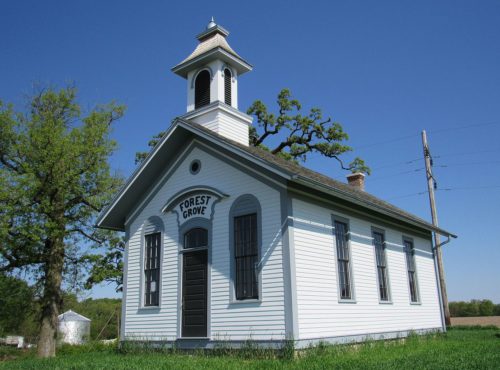Abandoned schools now being preserved as museums

Forest Grove No. 5, was the first school restoration in Iowa to be partially funded with state tax credits. The eastern Iowa school has been listed on the National Register of Historic Places. Photo by Sharon Andresen
By William Sherman
Iowa preservationists are giving abandoned buildings once used as country schools a second life as another institution for learning — this time as museums. This amazing transformation is taking place with buildings which, for the most part, were closed as schools more than 60 years ago.
During the past 20 years, more than 30 new rural school museums have been created in Iowa. Our state now has more than 230 country schools preserved as museums. New projects are in the pipeline. Those leading this effort are determined to maintain the one-room form of schooling which served as the main delivery system of education in Iowa from 1840 to 1940.
One of the newest efforts is underway at Harpers Ferry, a town in Allamakee County that overlooks the Mississippi River. In November 2016, the school was moved two miles down the Great River Road and placed on land adjoining the city park.
Organizers want to restore the school to the time period when it was closed in the early 1950s. It will be used not only as a school museum, but also as a place where additional Harpers Ferry history can be displayed, according to Jane Hasek, president of the Harpers Ferry Area Historical Society.
A grant obtained from the U.S. Department of Agriculture has allowed the group to establish a website (harpersferryheitage.org) to help keep people informed with the restoration progress.
One of the first efforts to create a rural school museum in Iowa began in 1968 when Scott County Conservation officials purchased an abandoned one-room school, Butler No. 2. The school was one of 39 rural elementary schools that were closed when the North Scott School District was formed in 1956. Many of the one-room schools, including Butler No. 2, were temporarily used as one-teacher/one-grade buildings until new elementary schools could be opened in 1967.
Scott County Conservation officials envisioned Butler No. 2 becoming a centerpiece for a “pioneer village.” In 1970, the Ehlers Blacksmith shop standing beside the Butler school was purchased. Next, an 1837 log cabin was moved there and the area was named Walnut Grove Pioneer Village. More buildings were added and today Walnut Grove includes 18 structures placed around a one-room school. It has become the largest collection of historical buildings in Iowa.
TO READ MORE ABOUT THIS STORY AND OTHER FASCINATING STORIES ABOUT IOWA HISTORY, subscribe to Iowa History Journal. You can also purchase back issues at the store.
